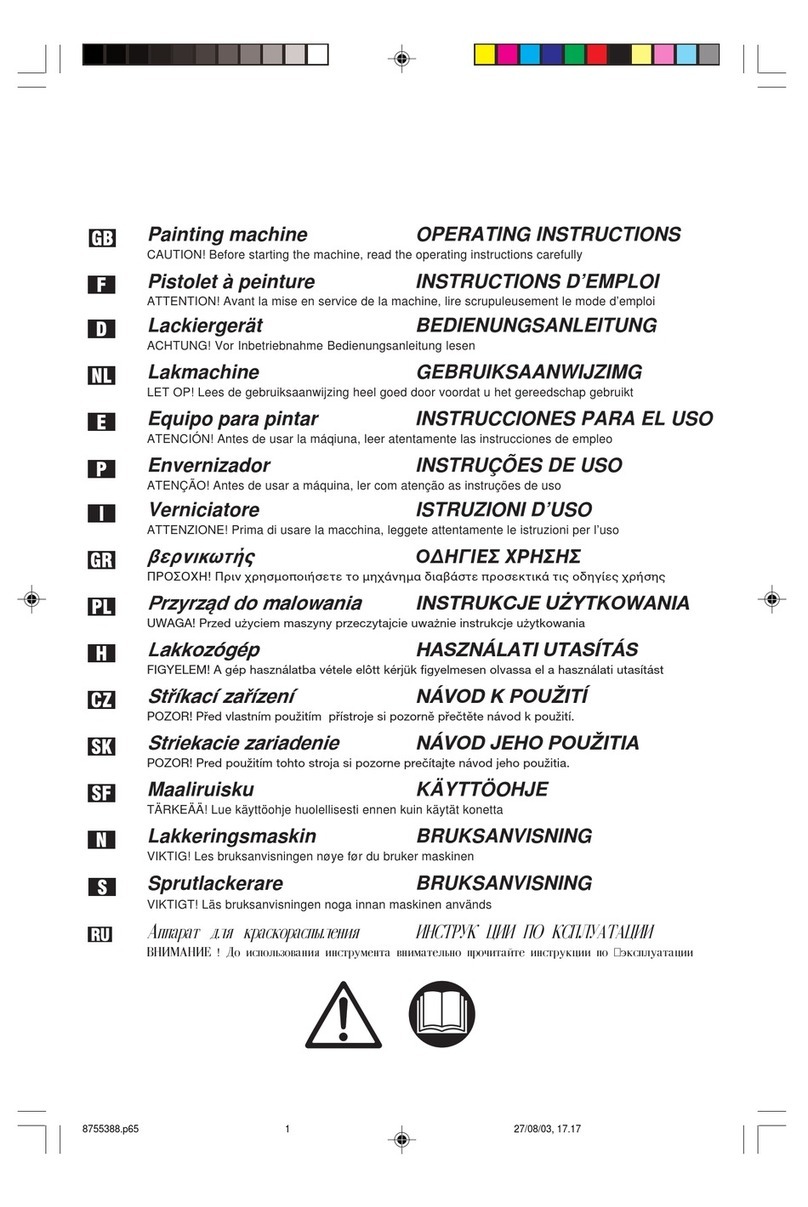
- 8 -
vernice (Fig. E1) svitando la ghiera della pistola
(20 Fig A), ruotando l’ugello a farfalla (21 Fig.A)
nella posizione desiderata e riserrando poi la
ghiera.
I getti orizzontali o verticali (HH-VV) sono consi-
gliati per le grandi superfici. Lo spruzzo rotondo
(CC) è invece utilizzato per i piccoli oggetti o
per i luoghi più difficili da raggiungere (angoli,
spigoli, ecc.).
Regolate la lunghezza della cinghia di trasporto
in modo da assicurare una posizione confortevo-
le e sicura. Riempite il serbatoio senza superare
il limite della scala graduata, per evitare che
la vernice intasi i fori superiori di immissione
dell’aria della pistola durante l’uso. Avvitatelo
poi al corpo della pistola. Verificate che l’inter-
ruttore ON/OFF (3 Fig. A) sia in posizione di OFF.
Collegate la spina del cavo di alimentazione alla
presa di corrente o ad una prolunga. Mettete
l’apparecchio a tracolla se necessario (Fig. D)
oppure posizionatelo fuori dalla zona di spruzza-
tura. Premete l’interruttore ON/OFF in posizione
di ON per avviare il motore.
ATTENZIONE! Durante la procedura di re-
golazione della pistola a spruzzo non premere
mai il grilletto.
Regolazione dello spruzzo
Con l’apparecchio avviato la portata d’aria che
attraverso il tubo dell’aria arriva alla pistola a
spruzzo fuoriesce continuamente dall’ugello
a farfalla (21 Fig.A) mentre la vernice viene
polverizzata soltanto quando si preme il grilletto
(11 Fig.A). Per regolare la portata di vernice si
consiglia di partire con la vite di regolazione
(18 Fig.A) completamente chiusa (girare in
senso orario). Tenendo premuto il grilletto si
apra lentamente la vite di regolazione fino ad
arrivare a nebulizzare la quantità desiderata di
vernice.
Modalità di spruzzatura (fig.E)
Il movimento della pistola deve essere regolare
e mantenuto sempre alla stessa distanza e
parallelo alla superficie da trattare (Fig. E3).
Si consiglia una distanza tra i 10 e i 30 cm a
seconda della regolazione e del tipo di vernice
utilizzato. E’ importante soprattutto avere un
movimento sempre parallello alla superficie
da trattare al fine di ottenere una verniciatura
omogenea. Non applicate mai un movimento
rotativo che potrebbe danneggiare la qualità
della rifinitura, lo spostamento dovrà essere
orizzontale se lo spruzzo è verticale o verticale
se lo spruzzo è orizzontale. Lo spruzzo rotondo
esige una distanza maggiore dall’oggetto da
verniciare. Vi consigliamo in ogni caso di fare
delle prove prima di iniziare a verniciare. Ad
ogni inversione rilasciate il grilletto e ripremetelo
quando si inizia il movimento di ritorno. Questo
permetterà, soprattutto per le grandi superfici
piane, di evitare segni di unione dovuti ad un
secondo passaggio.
MANUTENZIONE
ATTENZIONE! Prima di ogni controllo o ma-
nutenzione, staccate l’alimentazione elettrica
scollegando la spina dell’apparecchio.
Pulite regolarmente ed abbiate cura dell’apa-
recchio, vi garantirete una perfetta efficienza
ed una lunga durata.
Pulizia della pistola
ATTENZIONE! La pulizia della pistola deve
essere fatta scrupolosamente e subito dopo
l’uso. Se la vernice si secca al suo interno
l’operazione sarà molto più difficile, con il
rischio di non poter più utilizzarla.
ATTENZIONE! Non utilizzate solventi
infiammabili per la pulizia della pistola. Effet-
tuate la pulizia in un locale ben areato e ben
ventilato, rispettate le avvertenze illustrate
precedentemente.
Spegnete l’apparecchio e staccate l’alimenta-
zione elettrica.
Smontate il serbatoio assicurandovi di che tutto
il materiale di copertura presente nella pistola
rifluisca dentro al serbatoio. Versate la vernice
rimasta nel proprio contenitore e chiudetelo
ermeticamente.
Iniziate la pulizia dal serbatoio versando al suo
interno una piccola quantità di diluente adegua-
to al tipo di vernice, comunque con punto di
infiammabilità maggiore di 21°C.
Agitate il serbatoio con il diluente per qualche
istante svuotando poi il serbatoio. Ripetete que-
sta operazione fino a quando il diluente uscirà del
tutto pulito. Pulite da qualsiasi traccia di vernice
sia l’interno che l’esterno del serbatoio.
Pulite la guarnizione che si trova sotto il coper-
chio del serbatoio controllando anche che non
sia danneggiata o usurata.































